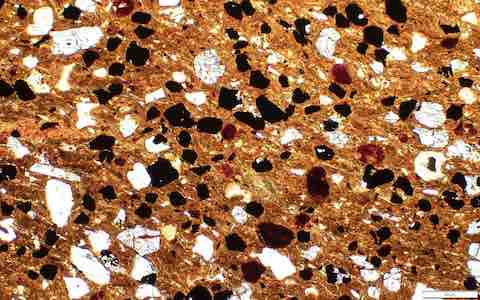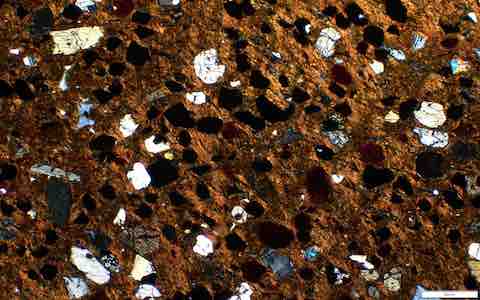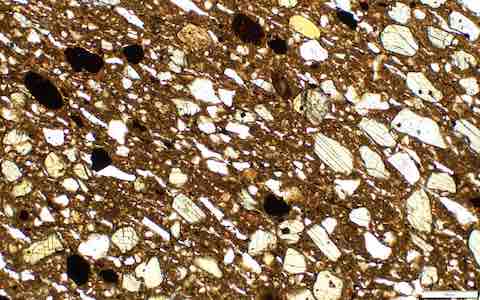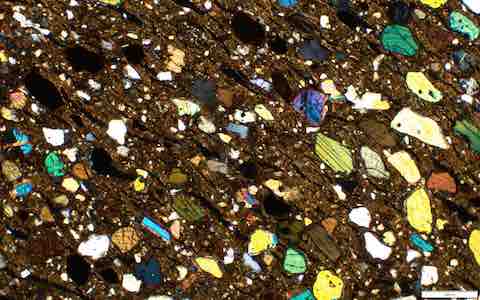
This glossary is intended as a common language, accessible resource for beginners and/or students interested to learn about petrographic anlaysis of archaeological pottery in Oceania. For more formal academic definitions see Dickinson's Temper Sands in Prehistoric Oceanian Pottery, Alex Strekeisen's site or the other references linked below.
The glossary covers:
Microscopes used for petrography have a polariser positioned between the light source and the slide, and an analyser (a second polarising filter, perpendicular to the first), between the slide and eye-piece. The polariser restricts the light rays entering the sample to only those oscillating in a single plane or direction. Minerals in the sample can split the plane light into 2 rays of different speeds. The analyser resolves the two rays.
Only one polarising filter is used in plane polarised light (PPL) conditions. The effects of the polariser alone, are some decreased light intensity and some change of colour (pleochroism) for some minerals, when the sample is rotated.
Under cross polarised light (XPL) conditions, both the analyser and the polariser are in use. The difference (birefringence) in how the two rays were refracted by the sample is visible in the interference colour of the crystals. How the rays are refracted depends on both crystal characteristics, the orientation of the crystal and the thickness of the section. As the crystal orientation is changed with rotation of the slide, at a particular angle the 2 rays will be refracted at the same speed. This refraction will cause the rays to destructively interfere with each other as they recombine in the analyser. This results in the crystal appearing black. The angle at which this occurs (relative to the crystal direction) is known as the 'extinction' angle. The maximum extinction angle is a distinguishing characteristic of a mineral.
See Perkins (2022) section 5, Labotka (2014) or Nelson (2017).

Calcareous (calcium carbonate in calcite or aragonite grains) fabric grains include those oringinating from reef debris or from limeclasts (fragments of limestone terraces).
While limestones are sedimentary rocks, they were generally, included in 'calcareous' by Dickinson, and so have been here. Beach sand, recognisable by the presence of bioclasts (i.e. 'skeletons' of minute reef organisms, such as foraminifera), was a commonly used temper in Oceania. For many Pacific atoll communities it was the only one available. Most Pacific sites feature at least one calcareous or hybrid calcareous-terrigeneous fabric. Unfortunately this makes reef debris calcareous fabrics hard to source to location. However their presence at an inland site is evidence of pottery (or at least temper) importation. In contrast, fabrics including limeclasts derive from eroded limestones and thus can potentially be more diagnostic. Limeclasts can be distinguished from bioclasts by their unordered internal structure, although the possibility of degraded bioclasts is a confounding factor. Places with limeclast fabrics include Timor (tpr200), the Marianas (tpr4), Vanuatu (tpr249) and Fiji (e.g. tpr373).
Calcareous inclusions are light grey in PPL and XPL (where they show pale higher order colours).
See Dickinson (2006) pg. 3, 20, 23, Strekeisen (2006-2020) calcite, carbonate rocks, or Perkins, (2022) section 7.4.3. Matches Getty AAT definition: calcite (300011078), carbonate rock (300011283), limestone (300011286) and Wikidata: calcareous (Q17005941), limestone (Q23757).

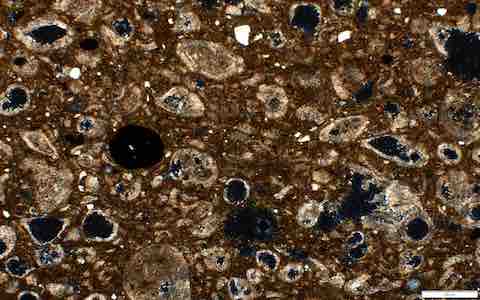
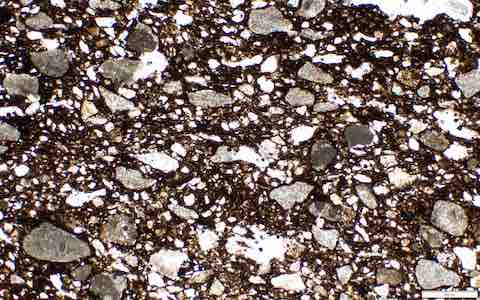
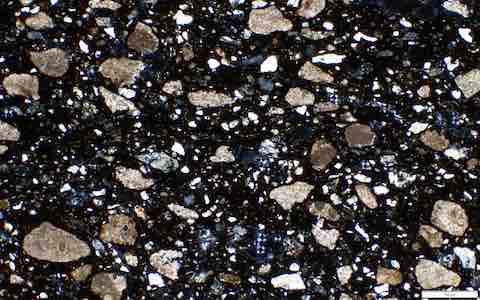
To the contrary of continental settings where quartz is often the most abundant mineral in pottery fabrics, quartz (silicon dioxide) is not universally presesnt in the geological formations of the Pacific region and so is an important distinguishing mineral in Pacific fabrics. It is a dominant mineral in dissected orogen and quartzose variant tectonic highland fabrics from up-lifted geology, and also occurs (generally in lower proportions) in the dacitic andesitic arc fabrics. Regions with quartzose fabrics include New Caledonia (e.g. tpr296), Maluku (e.g. tpr80), PNG (e.g. tpr270), Carolines (e.g. tpr42), Fiji (e.g. tpr388), Australia (e.g. tpr204), Tonga (e.g. tpr437) and the Marianas (e.g. tpr10). In the Marianas they are indicative of Saipan, the main island with dacitic rocks.
Polycrystalline aggregates of quartz, derived from quartz veins, and monocrystalline quartz are both identified as 'quartz' in the database. Sedimentary chert or metamorphic quartzite are identified as sedimentary/metasedimentary rock fragments.
Quartz minerals are white in PPL and white, grey or extinct (black) in XPL (i.e. first order colours). Quartz from plutonic igneous rocks, often have undulose (wavy) extinction, where the extinction travels across the crystal as the polarisation angle changes. In contrast quartz derived from volcanic rocks typically displays sharp extinction. Quartz crystals resistance to alteration or degradation (compared to feldspars) can also be a diagnostic feature.
See Dickinson (2006) pg. 23, 27, Strekeisen (2006-2020), or Perkins, (2022) sections 6.4.2, 14.1.1.1. Matches Getty AAT definition: quartz (300011132), Wikidata: quartz (Q43010), and Mindat mineral ID: quartz (3337).

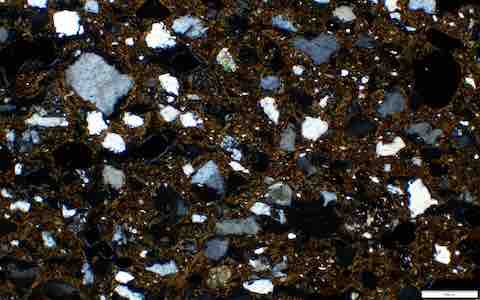
Feldspars (aluminium tectosilicates) found in Pacific fabrics include plagioclases and K-feldspars. Feldspars being the most common mineral on Earth, feldspathic fabrics occur in all Pacific regions, including the Marianas (tpr13), Solomon Islands (tpr110), Bismarcks (tpr198), New Caledonia (tpr308), Carolines (tpr210), Vanuatu (tpr233) and Fiji (tpr406). While plagioclase are often one of the dominant minerals in all the fabric types (andesitic arc, post-arc cover, oceanic basalt, tectonic highland and dissected orogen), the K-feldspars only occur in large proportions in the dissected orogen fabrics.
Feldspars are white in PPL and have black, white and grey coloured 'twinning' in XPL. Plagioclase twinning often appears as black and white stripes, while K-feldspars have more simple or cross-hatched twinning. Twins form by symmetrical crystal intergrowth sometimes in response to shear stress (deformation twinning).
See Dickinson (2006) pg. 23, Strekeisen (2006-2020), or Perkins, (2022) sections 6.4.3, 14.1.1.2. Matches Getty AAT definition: feldspar (300011087), Wikidata: feldspar (Q170258), and Mindat mineral ID: feldspar (1624).
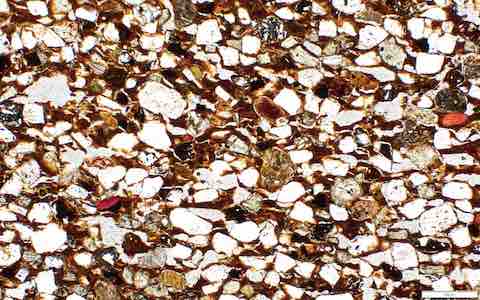
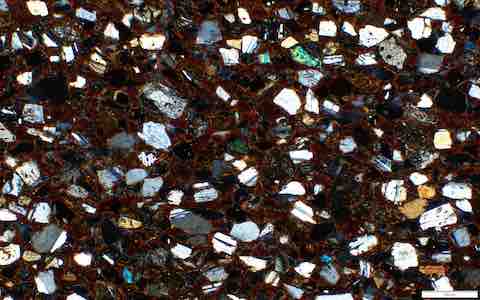
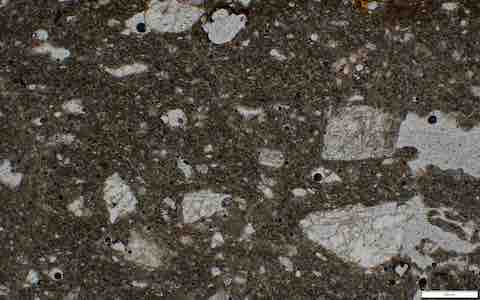
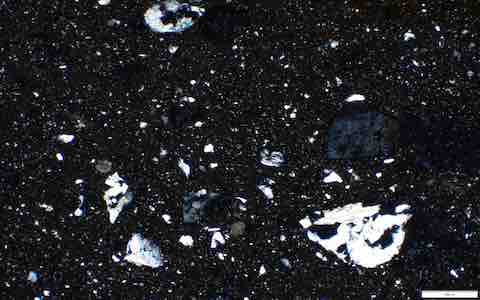
The most common of the amphiboles (ferromagnesian double chain (ino-) silicates) in Pacific fabrics are hornblende, oxy-hornblende, glaucophane and cummingtonite. Hornblendes are found in higher proportions in fabrics from the Solomon Islands (tpr143), Bismarcks (tpr197), PNG (tpr181), Batanes (tpr58), Banda (Maluku, tpr67), Fiji (tpr357) and Eua (Tonga, tpr437). Oxy-hornblendes are generally found in lower proportions than hornblendes, but are more common in some sherds of tpr348 from Kadavu, Fiji. Glaucophane, cummingtonite and perhaps actinolite are found in certain New Caledonian fabrics (tpr296a, tpr230 and tpr303) and are characteristic of continental bedrock.
In PPL hornblendes exhibit colours ranging from green to shades of yellow and brown. Some fabrics from the Solomon Islands are notably distinguishable by their different colours: yellow-brown (tpr111) or green (tpr121). Oxy-hornblende and cummingtonite are brown and glaucophane is light blue-violet in PPL. Amphiboles have bright (2nd order) colours in XPL and extinction angles of around 20°. They have two cleavage lines at 56° and 124°.
See Dickinson (2006) pg. 25, Strekeisen (2006-2020), or Perkins, (2022) sections 6.4.8, 14.1.3.2. Matches Getty AAT definition: hornblende (300380298), glaucophane (300380383) Wikidata: amphibole (Q17159), and Mindat mineral ID: amphibole (207).
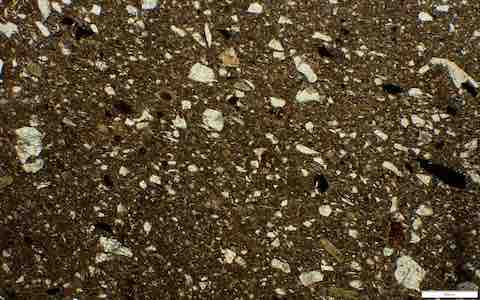
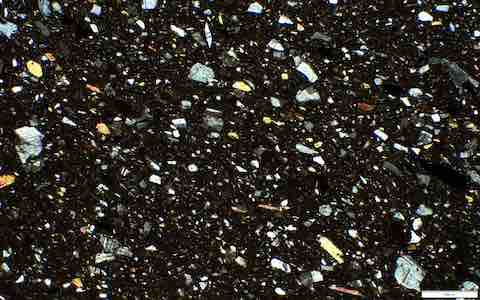
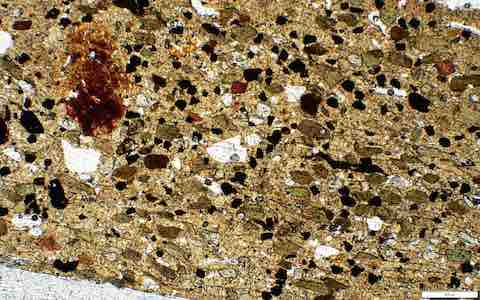

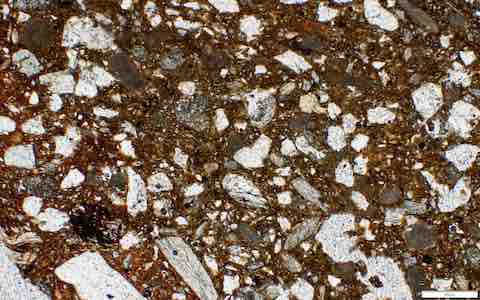
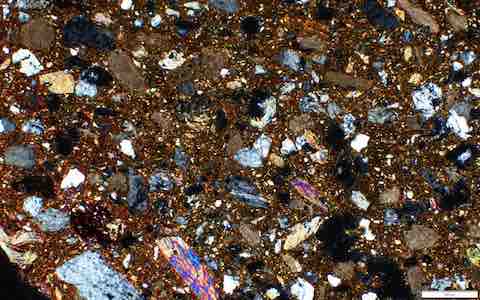

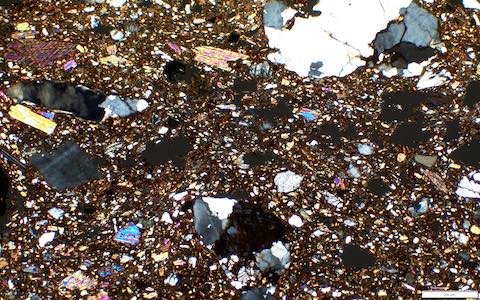
The most common pyroxenes (ferromagnesian single chain (ino-) silicates) in Pacific fabrics are the clinopyroxene (with monoclinic crystals) augite, although orthopyroxenes (with orthorhombic crystals), such as hypersthene, also occur. Pyroxenic fabrics are found in all regions, including Fiji (e.g. tpr334), Tonga (e.g. tpr438), Marianas (e.g. tpr17), Vanuatu (e.g. tpr165), Solomon Islands (e.g. tpr173), PNG (e.g. tpr274), Bismarcks (e.g. tpr317), Samoa (e.g. tpr292), New Caledonia (e.g. tpr307), Carolines (e.g. tpr52) and Marquesa (e.g. tpr441). Orthopyroxenes are found (with clinopyroxenes) in Tongan fabrics (tpr432), New Britain (Bismarcks, tpr192), Saipan (Marianas, tpr13) and Vanua Levu (Fiji, tpr386).
Pyroxenes are white (or very lightly green) in PPL and brightly coloured (2nd order colours) in XPL. They have two cleavage lines at 90° and 180°. Clinopyroxenes have maximum extinction at 40°, orthopyroxenes at 0° (parallel).
See Dickinson (2006) pg. 25, Strekeisen (2006-2020), or Perkins, (2022) sections 6.4.7, 14.1.3.1. Matches Getty AAT definition: pyroxene (300386789), Wikidata: pyroxene (Q192880), and Mindat mineral ID: pyroxene (9767).
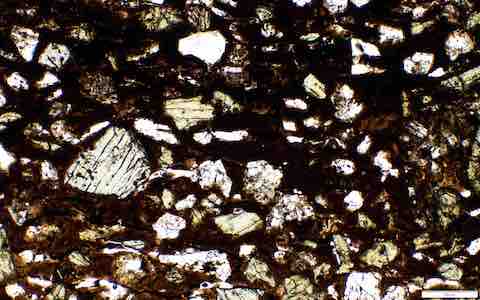
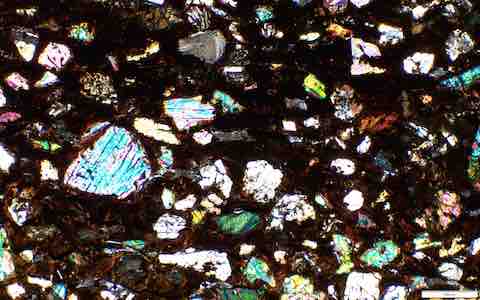
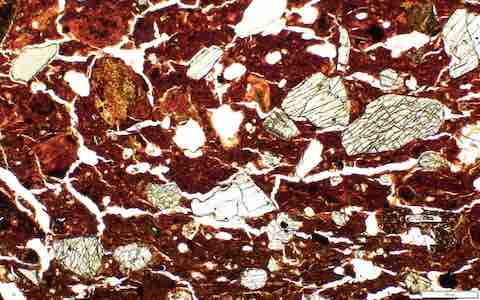

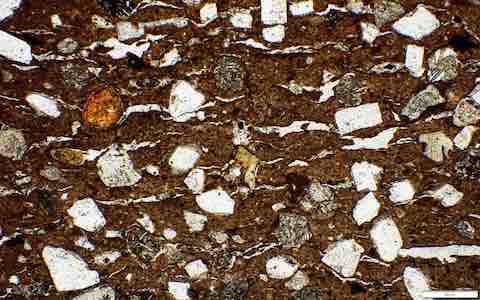
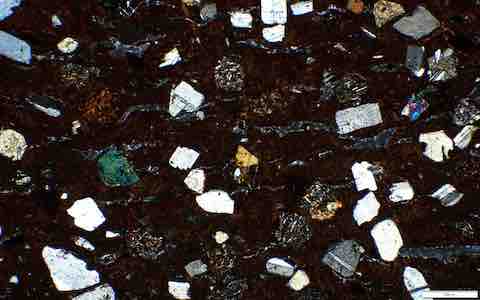
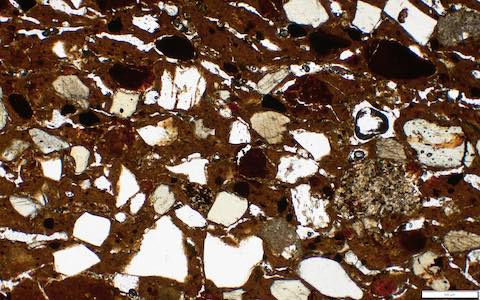


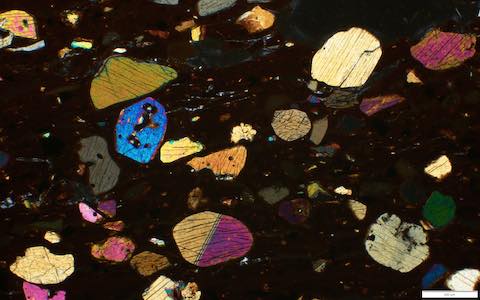
Opaque iron oxides in Pacific fabrics are predominantly magnetite (iron oxide spinel). Ilmenite (iron-titanium oxide), hematite and limonite also occur. Magnetite and ilmenite are derived from igneous or metamorphic rocks. In some situations, the iron oxides/hydroxides, limonite and hematite are derived from sedimentary rock (reworked iron-rich nodules). Most regions have a fabric, often a placer sand, with high levels of opaques, including Solomon Islands (tpr156), Bismarcks (tpr194), Vanuatu (tpr266), Fiji(tpr413), New Caledonia ( tpr304), Tonga ( tpr427), Marquesa (tpr441), and PNG (tpr300).
Opaques iron oxides are isotropic and appear black in PPL and XPL. With reflected light microscopy, magnetite and ilmenite appear gray, limonite appears white, and hematite appears bright red.
See Dickinson (2006) pg. 22, Strekeisen (2006-2020), or Perkins, (2022) sections 14.5.1, 14.5.2, 14.6. Matches Getty AAT definition: magnetite (300011110), ilmenite (300219700), hematite (300011105), limonite (300379931), Wikidata: magnetite (Q181395), ilmenite (Q190729), hematite (Q103223), limonite (Q193565) and Mindat mineral ID: magnetite (2538), ilmenite (2013), hematite (1856), limonite (2402).
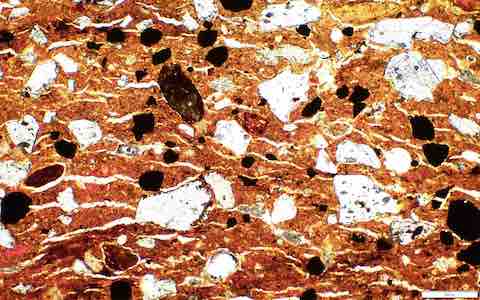

Olivine (ferromagnesian nesosilicate) is found in some Pacific fabrics, primarily those derived from basalts. It is found in lower propotions in fabrics, than in their source materials, as it is more susceptible to degradation than other minerals like pyroxenes. Some fabrics with olivines are documented in Samoa (tpr295), Solomon Islands (tpr154), Fiji (tpr392), Erromango (Vanuatu, tpr222a) and Tabar-Lihi-Tanga-Feni chain (Bismarcks, tpr134). Olivine is also found in lower proportion in fabrics from Pohnpei (Carolines, tpr210), Tonga (tpr436 ) and Marquesas (tpr441).
Olivines are white to pale green/brown in PPL and have bright (2nd order) colours in XPL. Their similar colours to pyroxenes can make them harder to distinguish, but they only have poor cleavage, and have higher relief. Extinction is at 0° (parallel).
Under oxidative conditions, olivines can alter to iddingsite which appear red-brown in PPL and XPL. Sometimes the alteration is complete, while often it can be observed as a ring around the crystal.
See Dickinson (2006) pg. 26, Strekeisen (2006-2020) on olivine, iddingsite, or Perkins, (2022) sections 6.4.10, 14.1.5.2. Matches Getty AAT definition: olivine (300147980), Wikidata: olivine (Q22693), and Mindat mineral ID: olivine (2983).
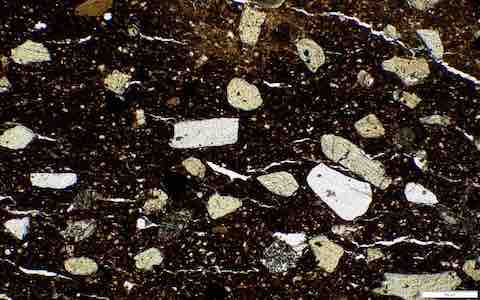

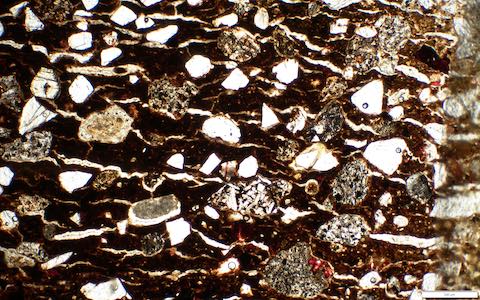
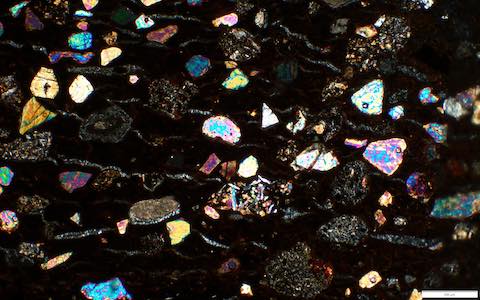
Micas (aluminium phyllosilicates) found in Pacific fabrics, include muscovite and the ferromagnesian biotite .
Exposure to heated liquids (such as those from cooling magmas) can alter feldspars to the mica sericite .
Mica grains are found in fabrics including the Carolines (tpr272), Maluku (tpr80) and PNG (tpr271), and at lower levels in other andesitic arc and dissected orogen fabrics.
Muscovite often has a flaky, irregular appearance, is white in PPL and has higher order (bright electric-like) colours in XPL. Biotite, typically has a rectangular appearance and appears brown or dark green when viewed in PPL. In XPL it displays higher order colours or appears dark brown. Biotite turns black, indicating extinction when its long direction is aligned parallel to the x or y axis. Sericite alterations exhibit a distinctive golden colour in PPL and XPL.
See Dickinson (2006) pg. 26, Strekeisen (2006-2020) on muscovite, biotite, sericite or Perkins, (2022) sections 6.4.5, 14.1.2.3.
Matches Getty AAT definition: muscovite (300011125), biotite (300209728), Wikidata: muscovite (Q106532), biotite (Q105794) and Mindat mineral ID: muscovite (2815), biotite (677).


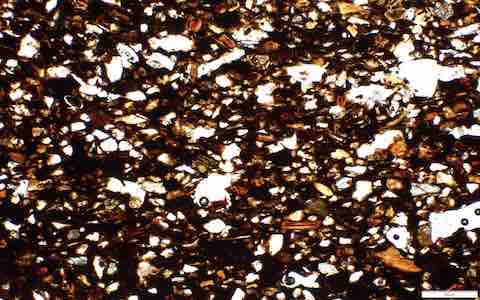
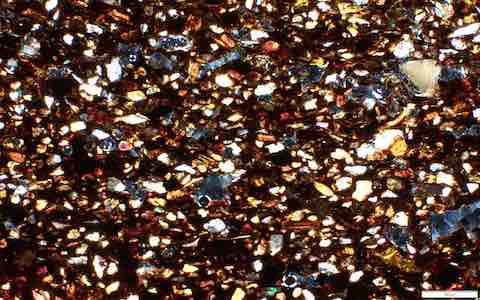
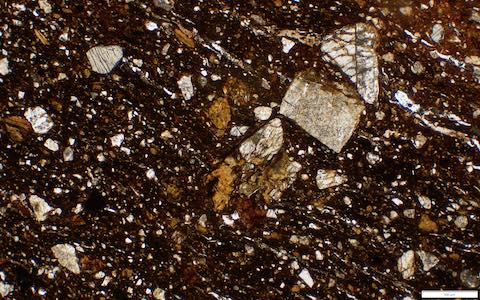
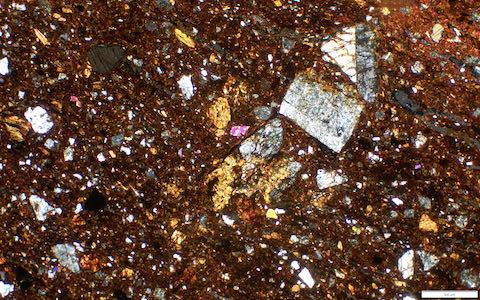
Epidotes (calcium ferro-aluminium sorosilicates) are generally found in Pacific fabrics in polycrystalline aggregates derived from rock alteration (metamorphic or hydrothermal). They are found in regions including PNG (tpr91), Fiji (tpr332), Vanuatu (tpr247), New Caledonia (tpr299), Bismarcks (tpr133), Solomon Islands (tpr138), Cagayan (Philippines, tpr55) and Carolines (tpr42).
Epidotes are clear to light yellow-green in PPL, and very brightly coloured (higher order) in XPL. They have one cleavage line at 25-40° and extinction is at 0° (parallel) when measured relative to the length of the crystal (not the cleavage line).
See Dickinson (2006) pg. 26, Strekeisen (2006-2020), or Perkins, (2022) sections 6.4.9, 14.1.6. Matches Getty AAT definition: epidote (300011086), Wikidata: epidote (Q272844), and Mindat mineral ID: epidote (1389).
Minerals found in Pacific fabrics, that are nonopaque (translucent) but isotropic, include garnets (a nesosilicate mineral group) and red chrome spinel (a non-silicate of the spinel group). In Pacific fabrics garnets are not found in abundances above 5%, but occur in fabrics from Buru (Maluku, tpr69) and New Caledonia (tpr296). Red chrome spinels occur in selected fabrics from PNG (tpr183) and New Caledonia (tpr311).
Garnets are clear and red chrome spinels are a dark red colour in PPL. Both are black in XPL.
See Dickinson (2006) pg. 25, Strekeisen (2006-2020) garnet, or Perkins, (2022) sections 14.1.5.1, 14.5.2. Matches Getty AAT definition: garnet (300011097), Wikidata: garnet (Q105368), chromspinel (Q56314668) and Mindat mineral ID: garnet (10272), Cr-spinel (7699).
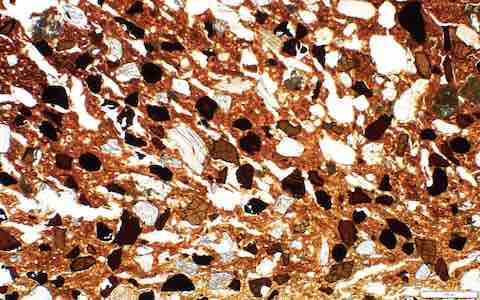
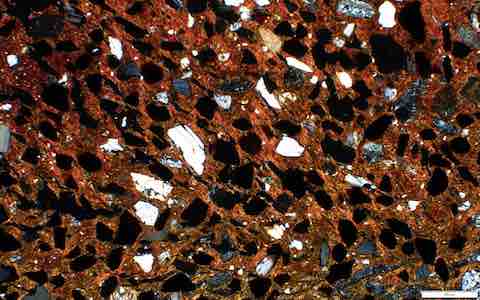
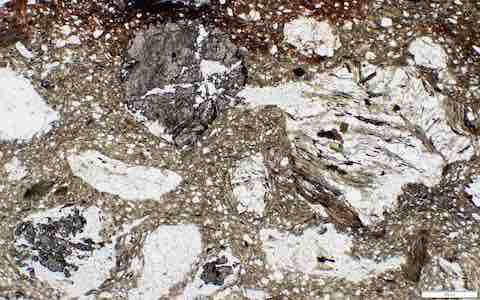
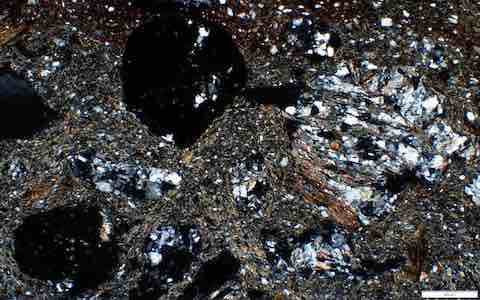
Igneous rocks are derived from crystallised magma. Igneous rocks are classified by crystal size, which is dependent on magma cooling time. In volcanic rocks, the magma cooled on the earths surface (i.e. lava) results in an aphanitic (very fine) texture, whereas the slower cooling underground, in plutonic rocks results in larger crystals (i.e. a phaneritic texture). The different proportions of K-feldspars, quartz, plagioclase, pyroxenes, olivines, micas and amphiboles, give rise to different rock types. The most common volcanic rock types in Pacific fabrics include andesite, basalt and dacite, with some rhyolite. The more common plutonic rock types include diorite, granodiorite, and gabbro, with some granite and peridotite.
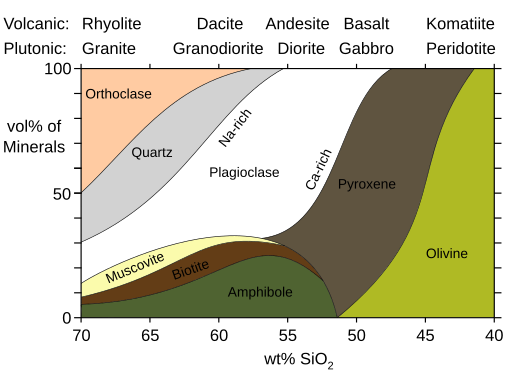 Woudloper, Public domain, via Wikimedia Commons
Woudloper, Public domain, via Wikimedia Commons
All regions contain at least one fabric variant dominated by igneous lithic fragments, including Vanuatu (tpr250), Marianas (tpr20), Samoa (tpr293a), Bismarck (tpr180), Fiji (tpr410), Tonga (tpr374), and PNG (tpr88). Igneous volcanic rock textures include vitric, felsitic, microlitic, and lathwork. For plutonic rocks, microphaneritic is used for fragments with smaller crystals, like the hypabassal and microdiorites , while plutonic is used here for larger crystals. However, it is important to note that the distinction between the different textures is operator subjective, and should be taken as a guide only and refer to fabric images where possible.
See Dickinson (2006) pg. 22, 26, Strekeisen (2006-2020) on plutonic, volcanic, or Perkins, (2022) section 6. Matches Getty AAT definition: igneous rock (300011178), Wikidata: igneous rock (Q42045), and Mindat mineral ID: igneous rock (48017).
Vitric (glass) fragments are traditionally included as igneous rock fragments, as they derive from magma cooled rapidly, sometimes from pyroclastic debris. The colour of the glass varies from brown or red (from mafic sources, more rich in metals like iron and magnesium) to tan or colourless (from felsic, less ferromagnesian sources). Vitric fragments from volcanic ash can show curvilinear and branching, and are generally clear. Vitric fragments from pyroclastic flows have eutaxitic textures with elongated vesicles. Vitric fragments with more rounded vesicles have a pumiceous texture. Fabrics with vitrics come from areas including, Vanuatu (tpr233), Marianas (tpr25), Samoa (tpr294), Bismarcks (tpr119), Tonga (tpr374) and Carolines (tpr211).
See Dickinson (2006) pg. 21, 26, 50, 110, or Strekeisen (2006-2020) on glass, pumice, vitrophyric. Matches Getty AAT definition: volcanic glass (300263800), Wikidata: volcanic glass (Q107749), and Mindat mineral ID: glassy igneous rock (50714).
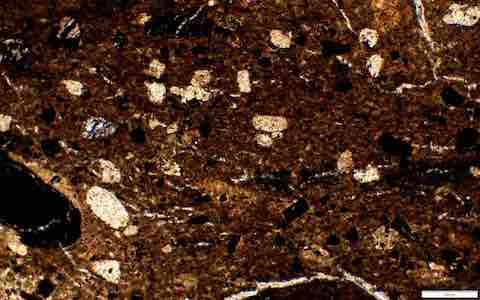
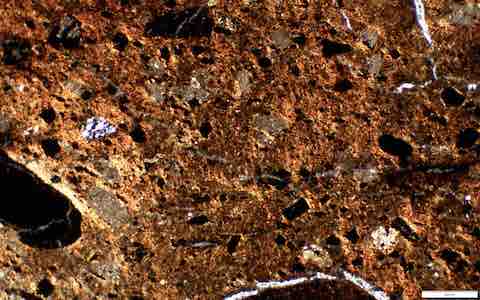
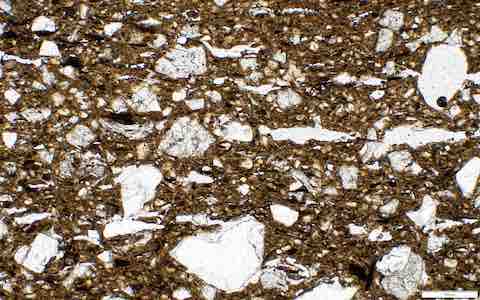
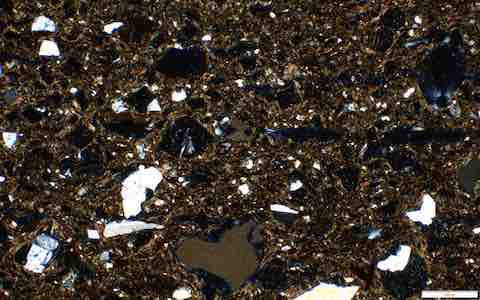
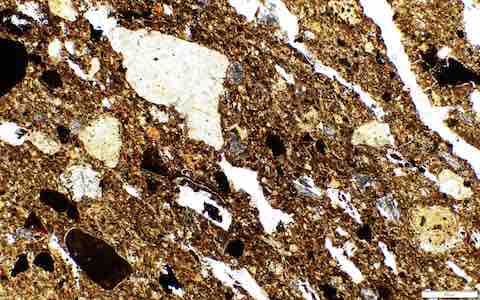
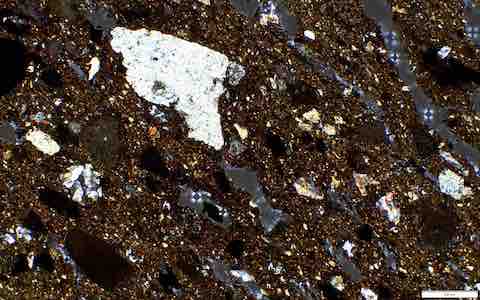
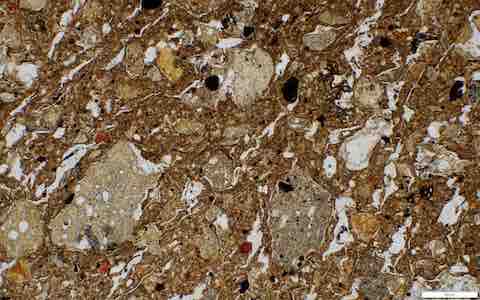

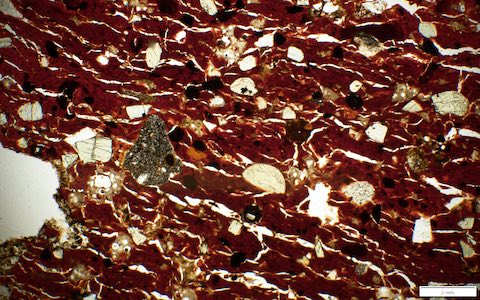
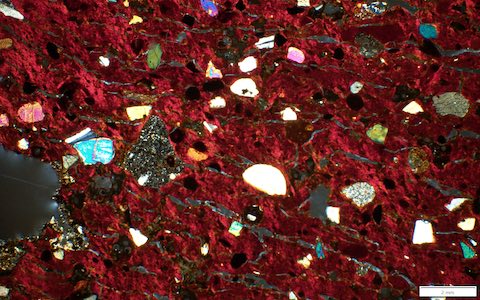
Felsitic fragments contain crystals with irregular shapes, and mainly derive from dacite or felsic andesite. They are commonly contain plagioclase microphenocrysts in a mosaic microcrystalline quartz-feldspar groundmass formed from devitrified glass. Felsitic fragments can have granular or more seriated textures depending on the pervasiveness of the devitrification. Fabrics containing felsitic fragments occur in most regions, particularly those with andesitic or dacitic sources including Vanuatu (tpr250), Carolines (tpr250), Maluku (tpr190), Samoa (tpr293a), Solomon Islands (tpr144), Bismarcks (tpr179), Fiji (tpr343a) and Tonga (tpr209).
See Dickinson (2006) pg. 27, or Strekeisen (2006-2020) on felsitic. Matches Wikidata: felsitic texture (Q16721473).
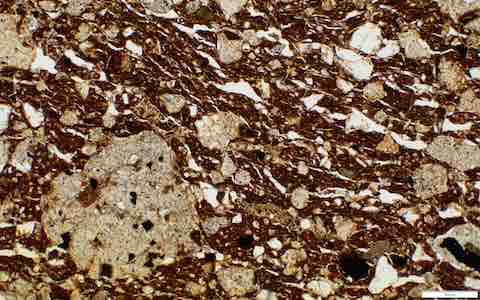
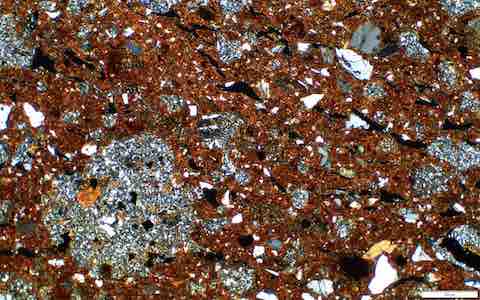
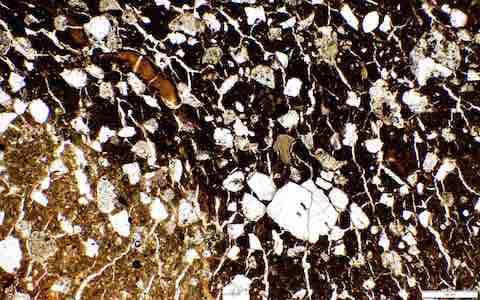
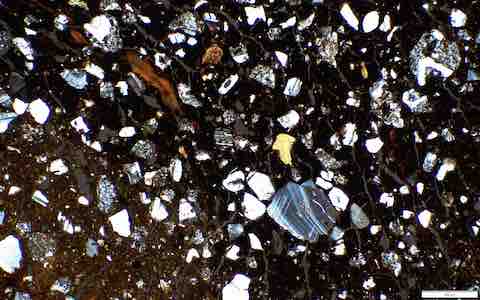
Microlitic fragments contain tiny plagioclase (usually) crystals with generally elongated shapes, that can be tightly packed (pilotaxitic), or more spaced out in a glass matrix (hyalopilitic). Those with crystals which became aligned when flowing when the lithic was liquid are called trachytic. They are found primarily in andesitic and basaltic andesites in regions including Vanuatu (tpr248), Solomon Islands (tpr172), Samoa (tpr293b), Bismarcks (tpr178), Futuna (tpr325) and Fiji (tpr344).
See Dickinson (2006) pg. 27, or Strekeisen (2006-2020) on hyalopilitic, pilotaxitic. Matches Wikidata: microlitic texture (Q12131213).
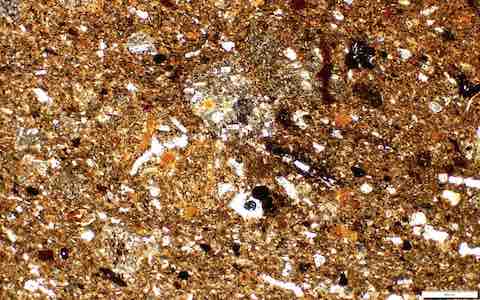
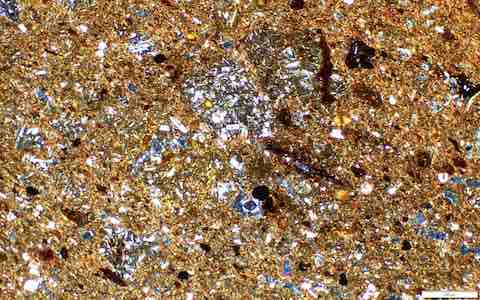
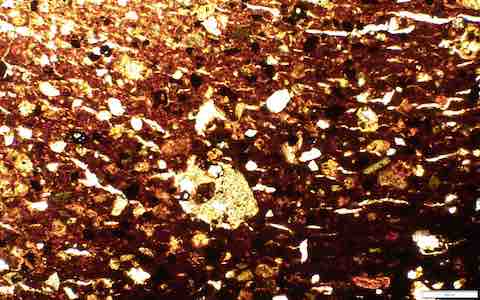
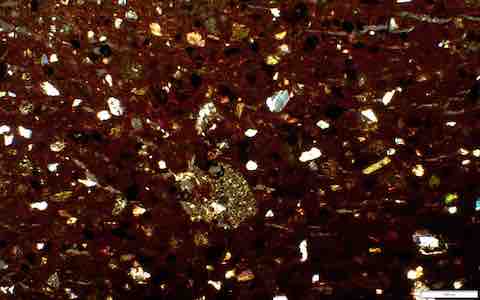


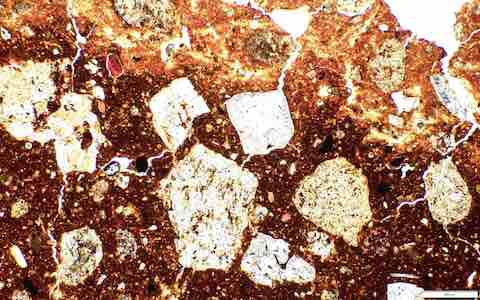
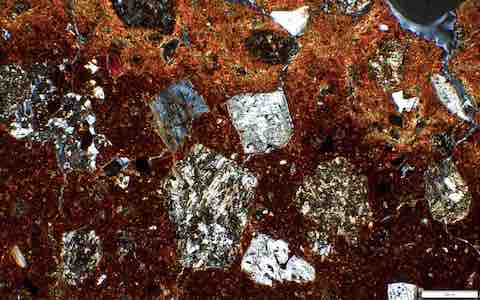
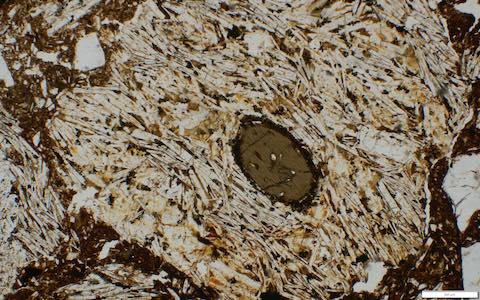
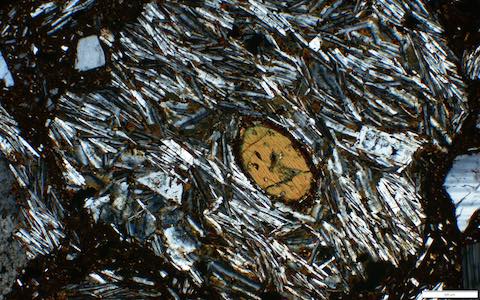
Lathwork fragments contain larger (often plagioclase, pyroxenes or olivine) crystals. They can be intersertal (set in glass) or intergranular (with other crystals such as pyroxenes). If crystals occur within the vitric fragment, they can be described as vitrophyric. They are found primarily in basalt or basanite fabrics in regions including Samoa (tpr294b), Uvea (tpr328) and Fiji (tpr333).
See Dickinson (2006) pg. 27, or Strekeisen (2006-2020) on intergranular, intersertal. No direct vocabulary matches.

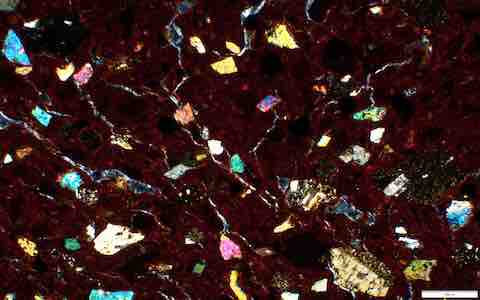
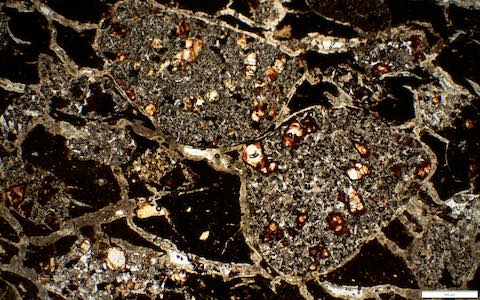
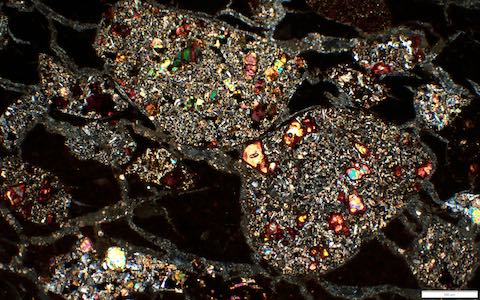
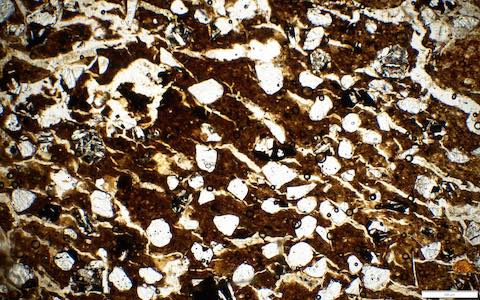
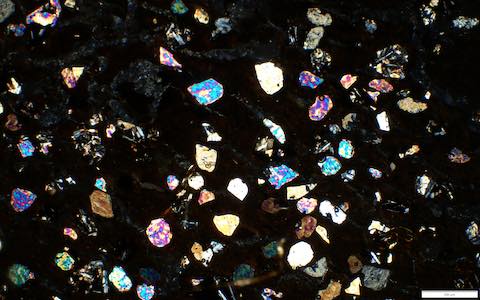
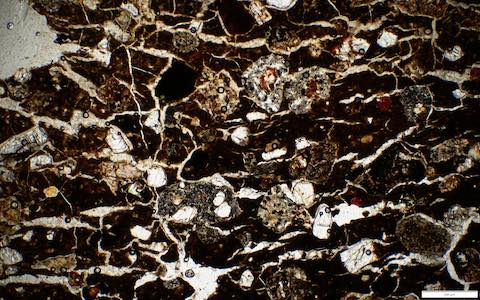
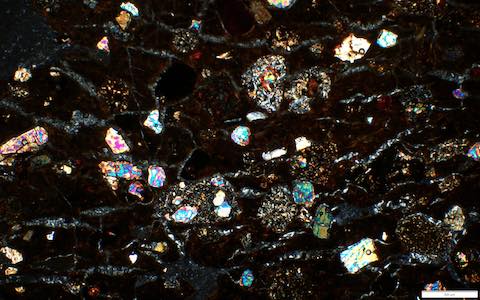
Lithics with Dickinson often used the term 'microphaneritic' to include the hypabassal to plutonic spectrum of fragments containing crystals ranging in size. Hypabassal fragments characterise fabrics from Solomon Islands (tpr127) and other microphaneritic fabrics include those from Vanuatu (tpr254). Larger plutonic fragments are found in fabrics from PNG (tpr270), Bismarcks (tpr314) and the Solomon Islands (tpr276).
See Dickinson (2006) pg. 26, Strekeisen (2006-2020) plutonic, or Perkins, (2022) section 14.1.2.3. No direct vocabulary matches.
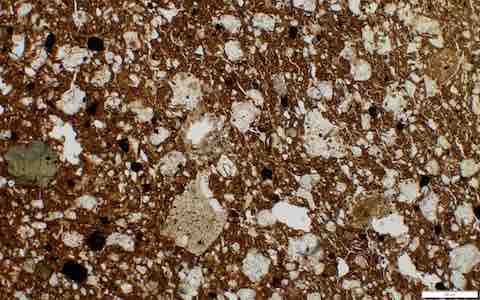
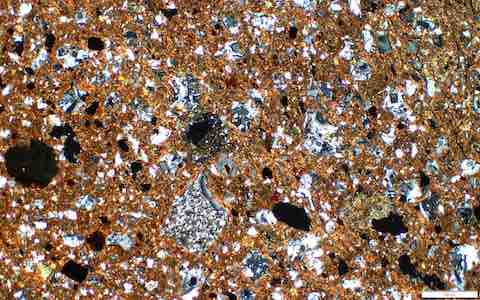
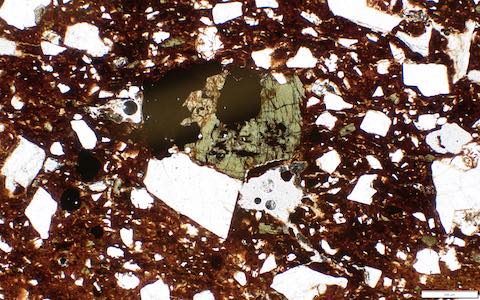
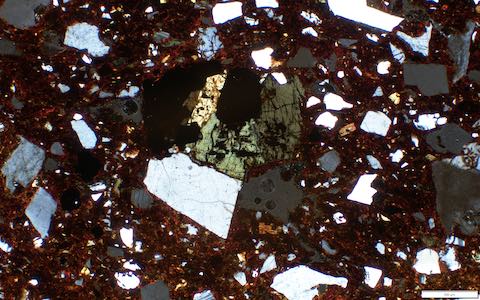


Metavolcanics are igneous rocks that have been altered by high pressures and or temperatures, giving them a foliated appearance. In Pacific fabrics, the metavolcanics found include actinolite-chlorite-albite greenschists, ultramafic serpentinites, and amphibole-plagioclase amphibolites.
Source regions for metavolcanic fabrics include Carolines (tpr272 with greenschist) and New Caledonia (tpr303, featuring amphibolite with feldspar-cummingtonite and tpr310, featuring serpentinite).
See Dickinson (2006) pg. 27, Strekeisen (2006-2020), or Perkins, (2022) section 8. Matches Getty AAT definition: metavolcanic (300011437), Wikidata: metavolcanic (Q6823306) and Mindat mineral ID: metavolcanic (51450).
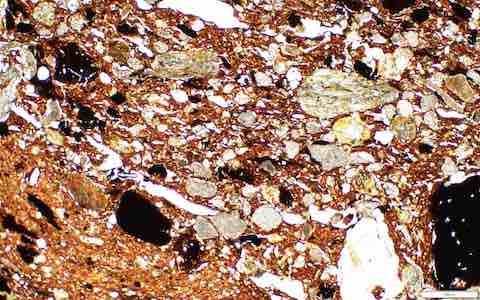
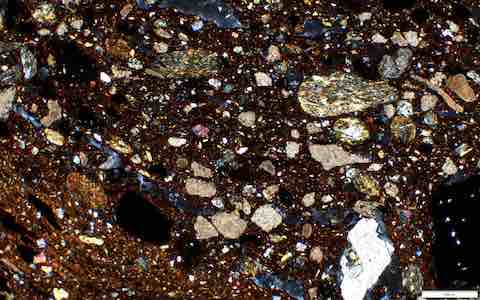
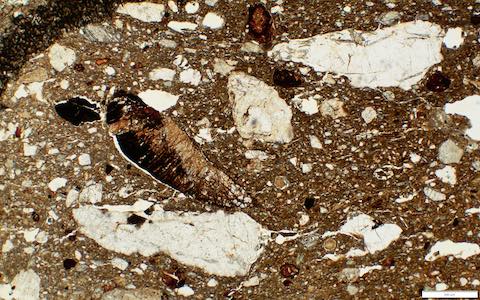
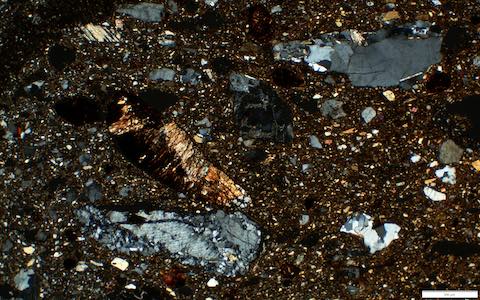
Sedimentary rocks are formed by accumulation/deposition of cemented sediments. They are identified as metasedimentary when they are altered by high pressure or temperature, which generally results in striated crystals. Sedimentary rocks in Pacific fabrics, as per Dickinson, include chert (quartz microcrystalline aggregates), siltstone (quartz-rich), and argillite (shale or mudrock). Quartzite (quartz polycrystalline aggregates) and tectonite (slate and phyllite) are the two main metasedimentary fragments identified.
Regions with significant proportion of sedimentary and metasedimentary fabrics include Buru (Maluku tpr69), New Caledonia (tpr299), Carolines (tpr41), PNG (tpr88), Fiji (tpr343a), and the Philippines (tpr57).
See Dickinson (2006) pg. 27, Strekeisen (2006-2020) sedimentary, phyllite, quartzite or Perkins, (2022) section 7. Matches Getty AAT definition: sedimentary (300011273), chert (300011141), siltstone (300011383), argillite (300011276), quartzite (300011623), slate (300011646), phyllite (300011622), Wikidata: sedimentary (Q82480), chert (Q1070438), siltstone (Q565731), argillite (Q836062), quartzite (Q237883), phyllite (Q731880), slate (Q207079) and Mindat mineral ID: sedimentary (51426), chert (994), siltstone (49448), argillite (49445), quartzite (51087), slate (48638), phyllite (50064), tectonite (52857).
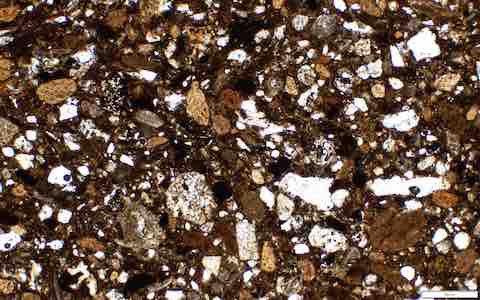




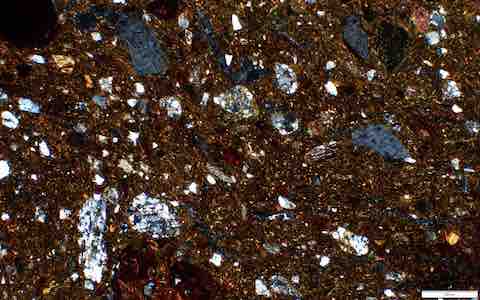
In the Pacific, the use of broken/crushed pottery (grog) as temper is mainly limited to the Carolines (e.g. tpr39) and possibly PNG (tpr179a). See Dickinson (2006) pg. 21. No direct vocabulary matches.
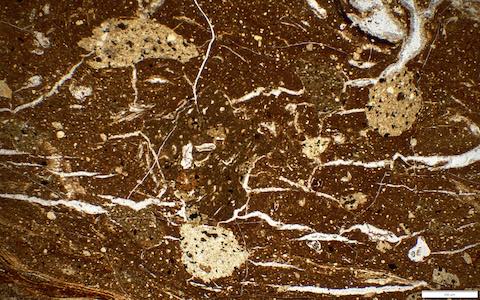
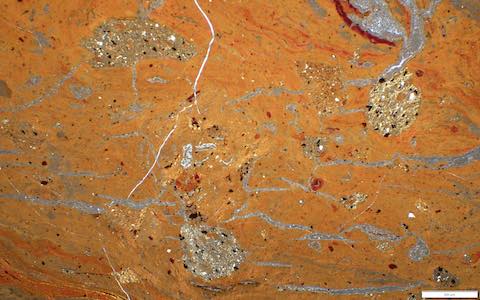
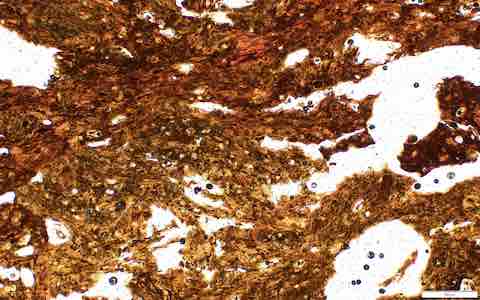
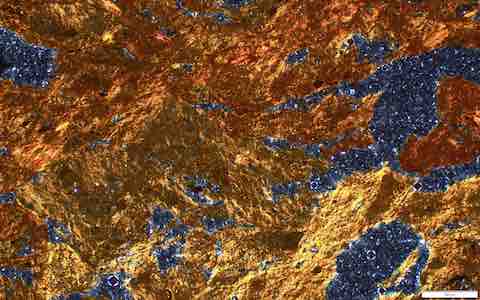
Basalts are igneous (volcanic) rocks from lava (surface magma) that cooled quickly, above (or near) the earth's surface. The quick cooling leads to fine crystal grains. Basalts have less silica (i.e. less quartz) than andesites, and predominately contain minerals such as plagioclase feldspars, clinopyroxene (and orthopyroxene) and olivine. These minerals sometimes occur as larger crystal laths, formed before the lava reached the surface. Rock fragments described as basaltic, may also include basanites and the more felsic hawaiite, as they can be difficult to distinguish visually.
Basaltic tempers are found in regions including the East Carolines (e.g. tpr211), Samoa (e.g. tpr294a) and Uvea (e.g. tpr328).
See Dickinson (2006) pg. 30, Strekeisen (2006-2020), or Perkins, (2022) section 6.6. Matches Getty AAT definition: basalt (300011222), Wikidata: basalt (Q43338) and Mindat mineral ID: basalt (48492).




Andesites are igneous (volcanic) rocks that have intermediate silica levels (between rhyolite and basalt). They are primarily made of plagioclase feldspars, clinopyroxenes, hornblendes and vitric volcanic rock fragments.
Andesitic tempers are found in regions such as Marianas (e.g. tpr21), Bismarcks (e.g. tpr191), Vanuatu (e.g. tpr214), and West Carolines (e.g. tpr53).
See Dickinson (2006) pg. 39, Strekeisen (2006-2020), or Perkins, (2022) section 6.6. Matches Getty AAT definition: andesite (300011213), Wikidata: andesite (Q181908) and Mindat mineral ID: andesite (48484 ).
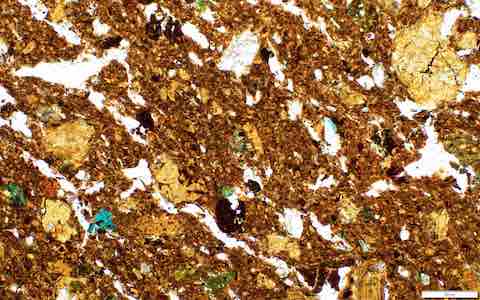
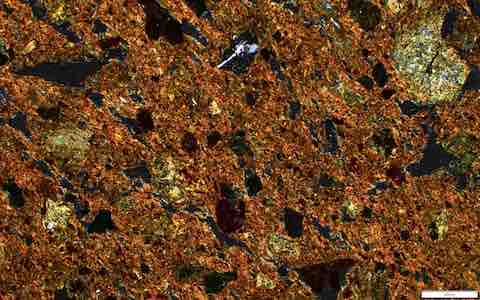

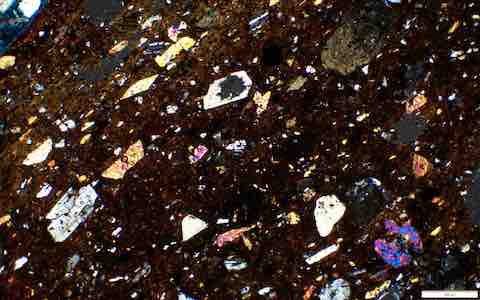
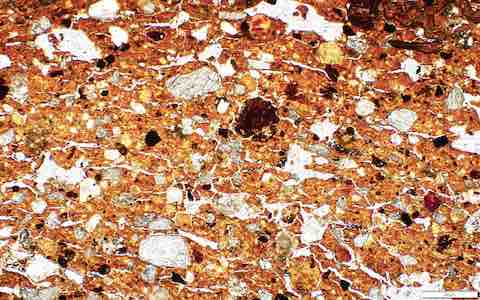
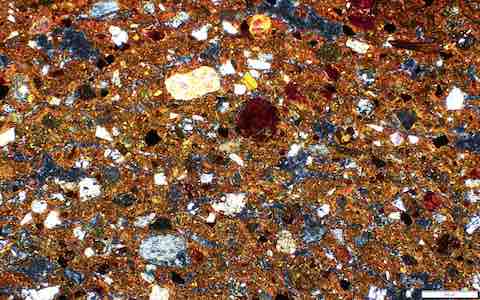
Dacitic rocks are similar to andesitic rocks, but contain higher levels of quartz. Within the Marianas, Saipan is the most likely source of dacitic fabrics (such as tpr5). The feldspars in dacites are primarily plagioclase and similar rocks with more alkali feldspars are called rhyolitic. Rhyolite defines the type of extrusive igneous rock with the highest content of quartz and K-feldspar. Rhyolitic fabrics are found in Haruku, Maluku (e.g. tpr78).
See Dickinson (2006) pg. 39, Strekeisen (2006-2020) on dacite, rhyolite, or Perkins, (2022) section 6.6. Matches Getty AAT definition: dacite (300011181), rhyolite (300011211), Wikidata: dacite (Q466481), rhylolite (Q190727), and Mindat mineral ID: dacite (48447), rhyolite (48451).
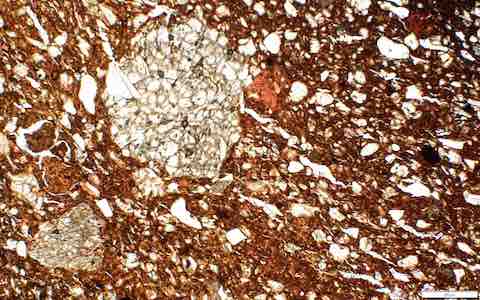
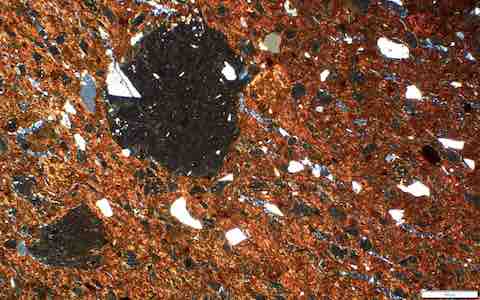
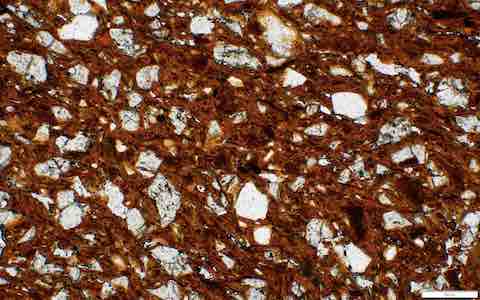
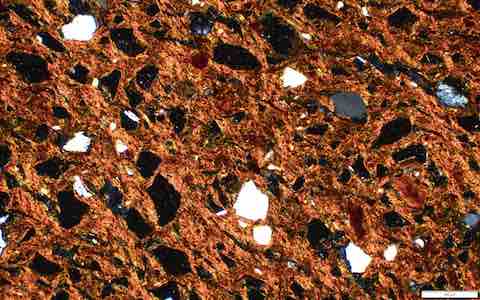
Dickinson classified the non-calcareous fabrics of the Pacific into five main groups: oceanic basalt, andesitic arc, post-arc/back-arc, tectonic highland and dissected orogen. These are based on the distribution of geological provinces associated with specific geotectonic frameworks.
The oceanic basalt fabrics of the Pacific, derive from the mantle melt magmas of hot-spot volcanic island chains. They are primarily sourced from alkali olivine basalts or basanites, although in some Samoan fabrics, there is some occurrence of the more felsic lithic varieties, from hawaiite to trachyte. They mainly contain olivines, clinopyroxenes and plagioclase, and have lathwork and mafic vitric lithic fragments. They are only found in East Carolines (e.g. tpr211), Samoa (e.g. tpr294a), Uvea/Rotuma (e.g. tpr328) and the Marquesas (tpr441).
See Dickinson (2006) pg. 11, 29 or Dickinson (1998) pg. 268. No direct vocabulary matches.
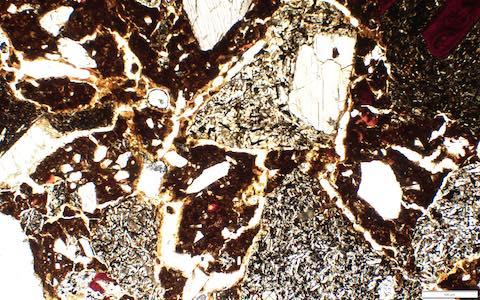
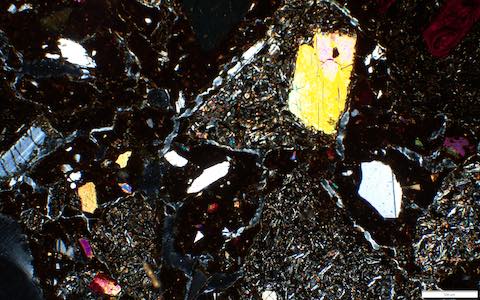


Andesitic arc fabrics are found in regions such as the Marianas (e.g. tpr13), Palau (Carolines, tpr53), Bismarcks (e.g. tpr192), Solomon Islands (e.g. tpr111), Vanuatu (e.g. tpr225), Banda (Maluku, tpr203), Kadavu (Fiji, tpr348) and Tonga (e.g. tpr348), where volcanic island arcs were induced by plate subduction. Unlike oceanic basalts, the andesitic arc fabrics can have mineral and rock contributions from mantle sources and the mantle-melt inducing subducting plates. Like the oceanic basalts, they can also have plutonic contributions from intrusive dikes and sills. The tempers are dominated by andesite and basalt lithic fragments, with microlitic, felsitic and vitric textures, and the andesite minerals (plagioclase, clinopyroxene and sometimes hornblende). Quartz and quartz containing dacitic or rhyolitic rocks occur in selected 'andesitic arc' fabrics, along with crystals of orthopyroxene, olivine, oxyhornblende and biotite.
See Dickinson (2006) pg. 13, 38 or Dickinson (1998) pg. 268. No direct vocabulary matches.
 MagentaGreen, CC BY-SA 3.0, via Wikimedia Commons
MagentaGreen, CC BY-SA 3.0, via Wikimedia Commons
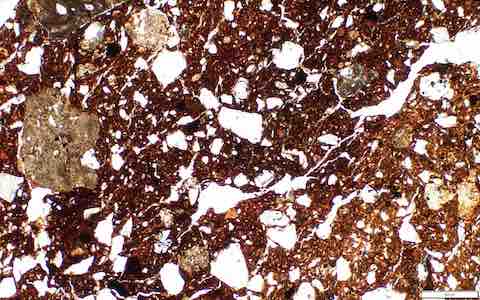
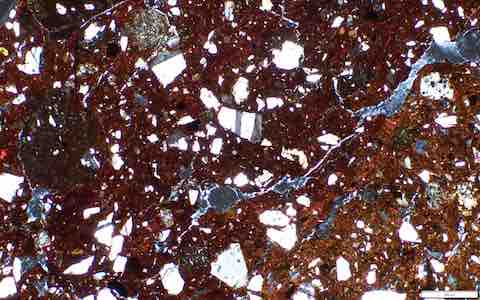

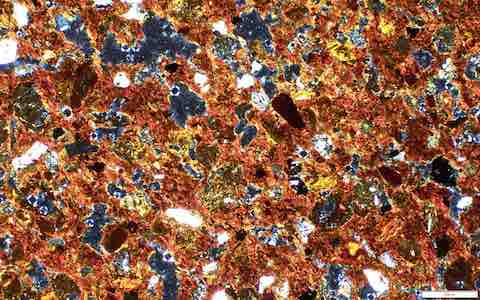


Post-arc and back-arc fabrics come from volcanic eruptions occurring in extinct volcanic arcs, that are not due to plate subduction i.e. dormant island arcs. Post-arc eruptions occur through rifted island arcs, due to geological events such as tectonic rotation and seafloor spreading. Back-arc eruptions occur through the oceanic crust due to crust spreading. Post-arc tempers are indigenous to the Tabar-Lihir-Tanga-Feni (TLTF) Bismarck island chain (tpr134), Futuna/Alofi (e.g. tpr327) and multiple areas in Fiji (e.g. tpr364). Back-arc tempers are found in Tikopia/Anuta (e.g. tpr244) and the Admiralty Group in the Bismarcks (e.g. tpr94). Clinopyroxenes, plagioclase, and lithics of basalts or shoshonite (a basaltic trachyandesite), dominate both tempers.
See Dickinson (2006) pg. 13, 75. No direct vocabulary matches.


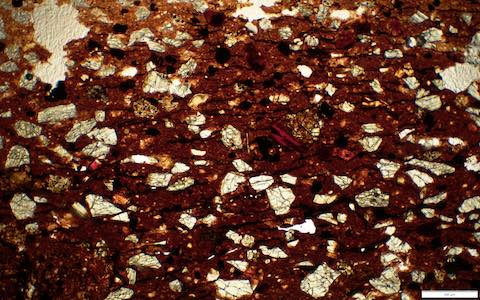
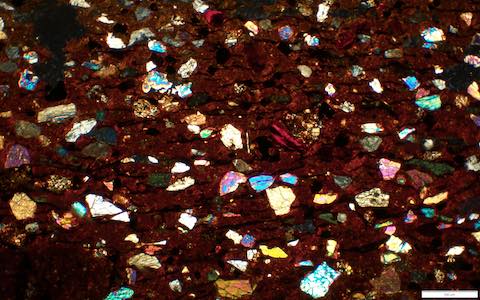
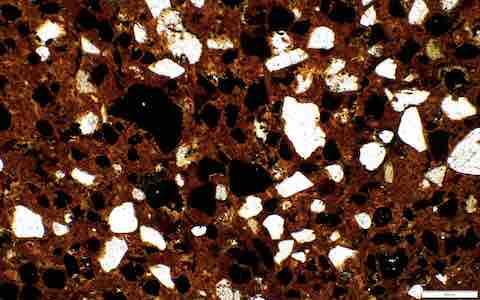
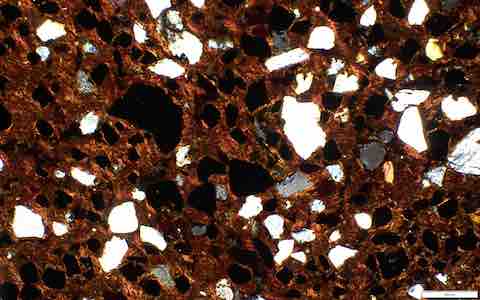
Tectonic highland fabrics derive from subducted plate rocks, that have been uplifted and eroded, i.e. subduction complexes. Uplifting of metasedimentary strata from melanges and underthrust continental crust, has resulted in quartzose fabrics, with chert/metachert and slate/phyllite lithics (including those from Aru, Maluku (tpr63c) and outer Banda Arc, Maluku (tpr80), New Caledonia (e.g. tpr296), and D'Entrecasteaux, PNG (e.g. tpr447). While that from igneous and metamorphic mafic/ultramafic ophiolitic (up-thrusted oceanic basement), has results in variants dominated by clinopyroxene, plagioclase, and metabasaltic and diorite-gabbro plutonic lithics (such as tpr306 in New Caledonia, and tpr272 in Yap, West Carolines). The ophiolitic variants have diagnostic chrome-spinels and the metavolcanic serpentinite, while the quartzose fabrics have diagnostic amphibolic glaucophane. New Caledonia also has fabrics that are mixed quartzose and ophiolitic tectonic highland (e.g. tpr302).
See Dickinson (2006) pg. 13, 95 or Dickinson (1998) pg. 269. No direct vocabulary matches.


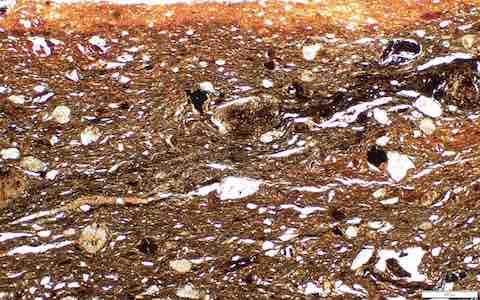
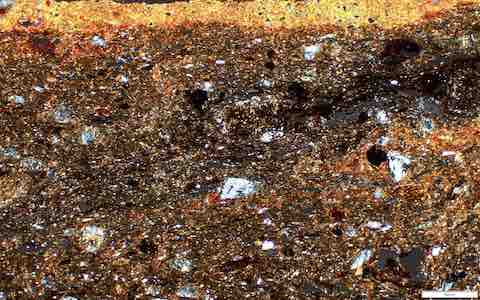
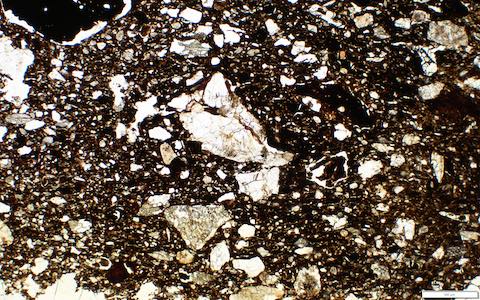
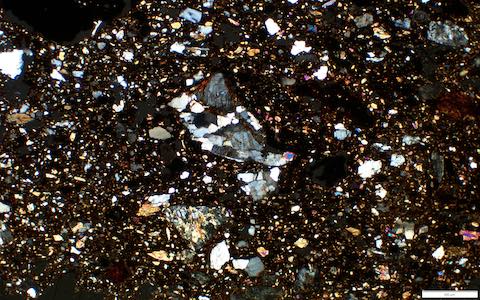
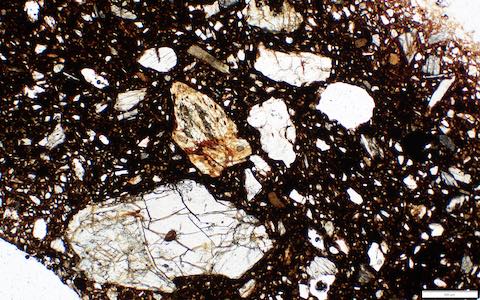
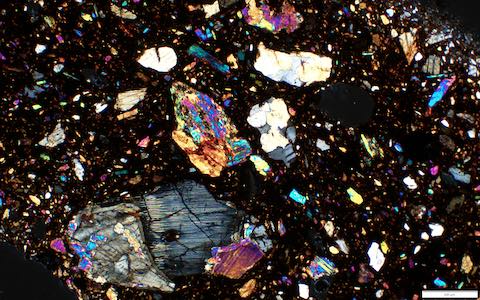

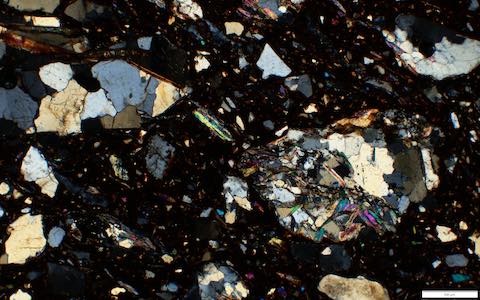
Dissected orogen fabrics originate from once underground plutonic rocks that have been up-lifted and exposed by erosion, i.e. eroded island arcs. As such they are dominated by plutonic lithics such as microgranite, and those with microphaneritic textures, as well as metavolcanics. They are the only type to have K-feldspars dominate, in addition to plagioclase, and quartz. They are found in PNG (e.g. tpr186), Solomon Islands (e.g. tpr138) and southern Viti Levu, Fiji (e.g. 341a).
See Dickinson (2006) pg. 13, 87 or Dickinson (1998) pg. 269. No direct vocabulary matches.
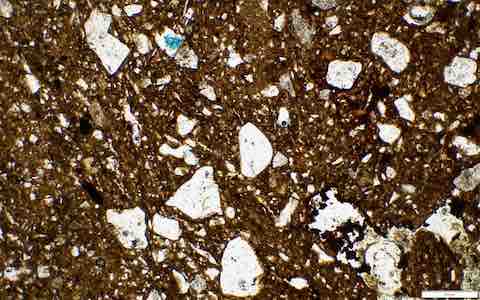
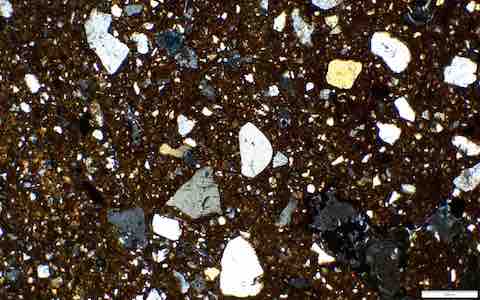


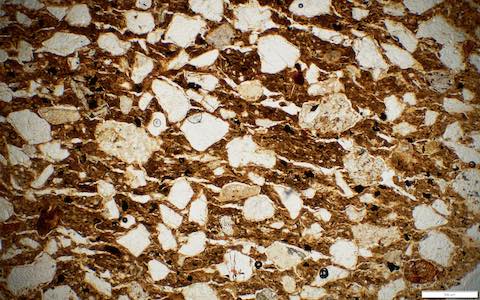
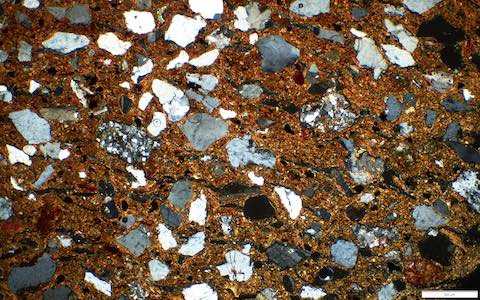
Placer fabrics have higher concentrations of high specific gravity inclusions, such as ferromagnesian silicate minerals such as iron oxides and pyroxenes. Generally these are derived from stream or beach sands manually added to clay. Often sites will show a range of 'placering' in different sherds. For example Teouma, Vanuatu has strongly (tpr228 and tpr229 ), partially(tpr226) and unplacered (tpr225) fabrics.
See Dickinson (2006) pg. 20 or Dickinson (1998) pg. 266. Matches Wikidata: placer deposit (Q2141583).
